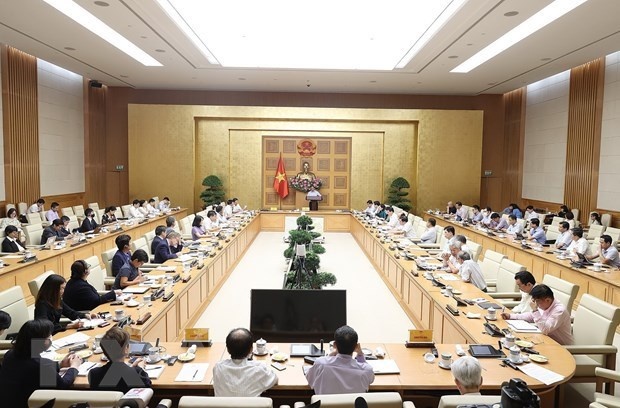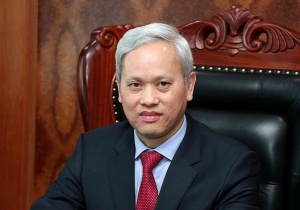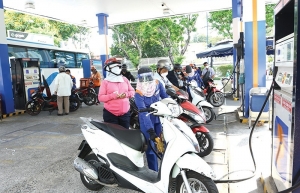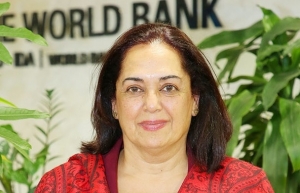Growth forecasts take price risks into account
Recognising the achievements of Vietnam’s socioeconomic development in the second quarter, in late July, the Asian Development Bank (ADB) retained outlooks of GDP growth at 6.5 per cent in 2022 and 6.7 per cent in 2023, while lowering the forecast of Asia-Pacific as a whole in 2022 to 4.6 per cent. “With sustainable recovery, Vietnam is rising as a spotlight of the region,” said Andrew Jeffries, the ADB’s country director at last week’s meeting with the prime minister along with Vietnamese governmental agencies.
 |
| The view of the meeting (Photo: VNA) |
The growth of Vietnam is driven by such factors as the expansion of trade, the faster-than-expected recovery in manufacturing, domestic travel, and the disbursement of public investment. According to the Ministry of Planning and Investment’s (MPI) General Statistics Office, GDP growth in Q2/2022 was 7.72 per cent on-year, surpassing all outlooks and the highest quarter GDP growth since 2011.
This was contributed by the increase of the index of industrial production by 11.2 per cent, total retail sales of goods and consumers by 42.6 per cent, and especially the number of international visitors to Vietnam by over 10 times.
Jeffries said that stable foreign direct investment inflows are contributing to defending itself against external risks, creating a fulcrum for the basic balance, and offsetting recent current account deficits. The continued growth of such funding in the processing and manufacturing industry confirms investors’ interest and unwavering confidence in Vietnam’s sustainable fundamentals, he added.
Tim Leelahaphan, economist for Thailand and Vietnam at Standard Chartered Bank, said that positive signals are spilling into the macroeconomy, and all indicators are forecasted to continue recovering. “The recovery will be more rapid in the second half of the year, especially due to the resumption of the tourism sector,” said Leelahaphan.
However, Vietnam, as well as other countries, is facing the risks of inflation. The high increase in prices of fuel and materials worldwide is putting pressure on inflation. However, Jeffries from the ADB noted that the abundant food supply in Vietnam will help control inflation this year.
Against inflation, the government has mitigated taxes on gas because taxes and fees account for 35 per cent of gas prices. Since April, the environmental tax has been reduced by 8 US cents for gas and 3-4 US cents for other fuels, which can be applied until the end of 2022.
In early June, the Ministry of Finance proposed to cut the tax down by 2-4 cents, which could take effect this month. The ministry is also considering a decrease in special consumption tax and VAT, which is waiting for the approval of the National Assembly in the next meeting in October.
HSBC said in its latest report that, although the current price pressure in Vietnam is not as clear as in other countries in the region, the inflation momentum is still climbing rapidly. While high energy prices are being seen, the biggest surprise in HSBC’s outlooks was a sharp increase in food inflation, with prices rising across a wide range of meat, eggs, and vegetables, and hit by escalating energy costs. Furthermore, core inflation rebounded to 2 per cent on-year for the first time in nearly two years, as the domestic demand continued to grow.
“We forecast that inflation in 2022 will be at an average of 3.5 per cent, and price pressure will be stronger in the second half of the year,” the HSBC report explained. “Based on projections, inflation is likely to surpass 4 per cent from the fourth quarter of 2022 to the second quarter of 2023.”
HSBC projects Vietnam’s GDP growth to be at 6.9 per cent in 2022, and 6.3 per cent next year.
Deputy Minister of Planning and Investment Tran Quoc Phuong also agreed that the pressure to raise prices is increasing when inflation from outside has begun to affect domestic production activities, especially in agricultural and industrial sectors, and poor performance in public investment disbursement. “Pressure and challenges in the last months of the year are rising,” said Phuong.
According to Standard Chartered Bank, price pressure, especially in terms of food and fuel in Vietnam, is likely to increase in the second half of this year and in 2023. The bank forecasts an increase in Vietnam’s GDP growth at 10.8 per cent in the third quarter and 3.9 per cent in the fourth quarter of this year. GDP growth for the whole year 2022 will reach 6.7 per cent.
The government has set a new target of GDP growth at 7 per cent in 2022, and controlling inflation at around 4 per cent.
 | Inflation maintained at around the target despite increasing fuel price Thanks to the actions of governments, agencies, and businesses, inflation up to 2023 will likely be about 4-5.5 per cent – the same or slightly higher than the target that was set forth. Nguyen Bich Lam, former director-general of the General Statistics Office, shared his expert opinion on the latest economic developments. |
 | Immediate hike risks tackled as inflation squeezes workers A continued hike in the prices of fuel and input materials for production are expected to drive enterprises and labourers into more difficulties, and affect Vietnam’s efforts to rein in inflation this year. |
 | Containing the inflation threat and related hazards The current situation confronts Vietnam’s policymakers with the difficult task of balancing the need to provide continued policy support to solidify the recovery with the need to contain emerging inflation and financial risks. |
What the stars mean:
★ Poor ★ ★ Promising ★★★ Good ★★★★ Very good ★★★★★ Exceptional
Related Contents
Latest News
More News
- Protect what’s next: towards a future free from meningococcal group B disease (December 05, 2025 | 18:00)
- New ILO report offers policy recommendations for disability inclusion (December 04, 2025 | 15:18)
- Maternal job loss may affect children’s mental health, research shows (December 03, 2025 | 19:11)
- Women lead Vietnam’s shift to climate-resilient agriculture (December 03, 2025 | 19:10)
- Experts highlight unpaid care work as key barrier to gender equality (December 03, 2025 | 15:15)
- Opportunities and inequalities for women workers in Vietnam's garment industry (December 03, 2025 | 09:00)
- Vietjet flights carry love to devastated central region (November 28, 2025 | 11:35)
- New initiative to boost the fight against domestic violence (November 26, 2025 | 10:00)
- South Korea funds IOM relief for Vietnam’s typhoon-affected communities (November 24, 2025 | 15:33)
- AI and human-centred values set to shape the future of HR in Vietnam (November 21, 2025 | 18:04)

 Tag:
Tag:





















 Mobile Version
Mobile Version